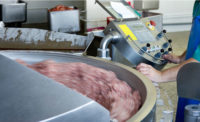
In recent years Lopez Foods' Oklahoma City plant has seen beef and sausage line remodeling as well as the addition of a 3,000-square-foot freezer.
Photo by Vito Palmisano
Photo by Vito Palmisano
Editor’s note: This article has been adapted from one by Andy Hanacek that appeared in the February 2008 issue ofNational Provisioner,a sister publication toRefrigerated & Frozen Foods.
Sometimes everyone needs to admit that they need a little help, and last year was that time for Oklahoma City-based Lopez Foods Inc. The beef and sausage patty processor - with facilities in Oklahoma City, Columbus, Neb., and Caryville, Tenn. - wanted to overhaul its company culture and management strategies to boost productivity and efficiency in its central plant in Oklahoma City.
Even though President and Chief Executive Officer Ed Sanchez was pleased with the company’s success through its 15 years in business, he believed it was time to take the next step. So, he suggested that Lopez Foods partner with Proudfoot Consulting, an Atlanta consulting firm, to increase the productivity and efficiency of Oklahoma City operations.
There were high expectations for the partnership, and Lopez Foods made sure to keep its employees well-informed throughout the process, explains Dave Lopez, assistant vice president and coordinator of Proudfoot’s STAR (“Systems, Training, Action, Results”) program at the plant.
“We were very open with everybody and had a bi-weekly newsletter that updated the associates,” he says.
Along with opening the lines of communication, Lopez Foods also was able to secure buy-in from its employees through a number of unique input strategies that Proudfoot implemented.
“Now, [employees] are participating in the decision-making process, and by them participating, it makes us all more efficient,” Lopez explains. “The efficiencies were not picked arbitrarily - there were time and motion studies done, so it was very well-orchestrated.”
Employee input led to several changes in the project - including staffing requirements. Sanchez says employees were able to see inefficiencies in the process that they couldn’t see before, leading them to question the amount of manpower dedicated to some tasks.“Things we thought would be a hard sell on the employees, they themselves have come up to us and said, ‘We can do this better,’ or ‘We don’t need five people here, we only need three,’” Sanchez adds.
Because of time-management analyses performed by employees and the Lopez-Proudfoot task forces, Lopez Foods was able to trim more than 20 positions from the plant. Today, Lopez has complete control over the program and it’s worked so well, Lopez says, that the company has a “laundry list” of other company processes to which it is prepared to apply the STAR Program. If the success of the program in the plant is any indication, employees elsewhere are likely to hop on board quickly.
One motivational tactic of note that the company developed in the last six months has had a big impact across operations. An Overall Equipment Efficiency (OEE) tracking system and board communicates to the entire company the big-picture targets it has for each of four key departments. The OEE formula takes into account throughput, up time and yield, and translates it into a percentage grade for the day.
When a department hits its target OEE for the day, it gets a green checkmark. If it misses its target, it gets a red mark. For every green checkmark registered during a quarter of the year, every single employee at the Oklahoma City facility gets $1.
“It’s fun to give away the money,” Lopez says. “That means we’re doing well; it’s a sign of success.”
After a year of changes, Lopez Foods now is settled in and better prepared to face the challenges of production with a different spin on strategies and corporate culture - thanks to Proudfoot’s guidance. The quantum leap in corporate thinking allows Lopez Foods to better serve its current customers and deal with the growth that has spurred it along for the past decade and a half. Rather than go it alone, Lopez Foods wisely chose to partner with a consulting firm to learn how to be a more efficient, productive company with an engaged, continuously driven-to-improve workforce.
Just the facts
Company:Lopez Foods Inc.Food plant(s) honored: Oklahoma City
Selection criteria: Employee Programs, Process/Packaging Innovation and Productivity
Employees: More than 500
Facility size: 200,000 square feet
Products: Hamburger patties, sausage patties, Canadian bacon
Executive Insights
Refrigerated & Frozen Foodstalks with President and Chief Executive Officer Ed Sanchez about Lopez Foods Inc.'s Oklahoma City beef and pork processing plant.Refrigerated & Frozen Foods: Looking back on 2007, what are you most proud of?
Ed Sanchez:What I'm most proud of is that we accomplished the major goals we set out to accomplish at the beginning of the year in a very difficult business environment - by this I mean the productivity initiative that we worked on with Proudfoot Consulting, an Atlanta-based international consulting firm. We said at the beginning of the year that we were going to accomplish that and it was an expensive venture. But we were able to do it and do it well.
We also had a large remodel on the packing end of our sausage line that we invested over $2.5 million in.
R&FF: What were the greatest challenges of the last year?
Sanchez:Our biggest challenges last year were commodity costs - corn prices. I think that the government has made a terrible blunder with the ethanol incentives. They really haven't thought through the impact on the food supply and food prices - they only thought through the impact on the fuel market. Corn has gone from $2.50 a bushel in 2006 to more than $5 in 2007 and there's still some pressure on that.
I think in terms of the productivity initiative, the biggest challenge was making the initial commitment to decide to do it. And once we got going, everything was pretty smooth.
R&FF: Talk about a few of your operations' strengths in relation to the "Food Plants of the Year" criteria. How did you develop these strengths?
Sanchez: We instinctively knew we had opportunities and we were chasing these opportunities through some continuous training and continuous education. For example, Richard Lane, our assistant vice president of operations here in Oklahoma City, had gone through some Six Sigma training and he was implementing some of that, but there was no quantum leap. I was really looking for a quantum leap, especially because our raw material costs were going up so much. The lack of quantum leap led me to say, "We've got to do something different to get it done."
R&FF: What industry issues most trouble you in plant operations? What steps are you taking to address these concerns?
Sanchez: As far as plant operations itself, technology continues to change, so we have to keep on top of that. The machinery today is much more complicated than what it used to be. Hence, you need a much savvier employee to be able to run that machinery - you have to hire someone that feels comfortable operating a computer and then come in and train them properly.
And training doesn't stop after hiring. I think that you have to have continuous training because the industry continues to change on the equipment side. We have training classes every month now for just about every employee and that's reduced our turn over substantially.
People, before we brought in Proudfoot and today, like working here because we run it as a family business.

